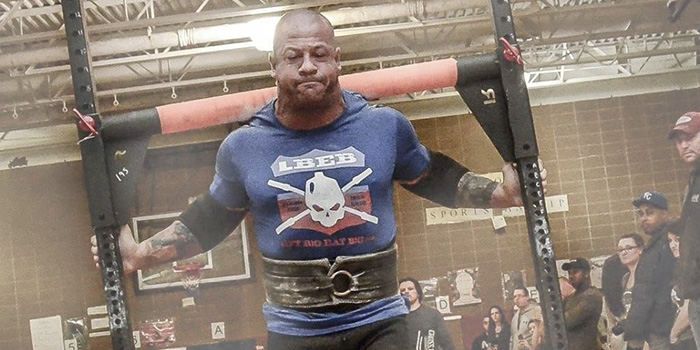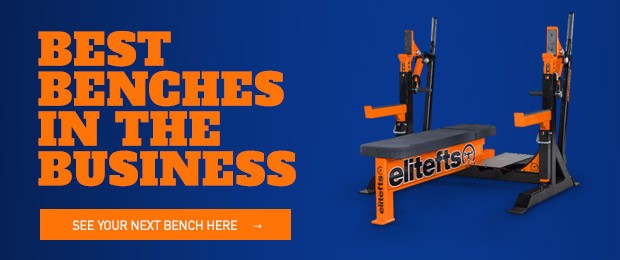
I’ve had a complicated love/hate relationship with the bench over my powerlifting career. I was never great at the bench, but I was able to make consistent progress through my first couple of years. My best bench in a meet is 445 pounds in the 242 class, so again, nothing special but not bad by any means. Shortly after that meet, I decided to do a charity bench press competition, and I fully tore my right pec major muscle in half. I’m sure many of you out there reading this have suffered a pec tear of some kind, and it’s generally the tendon, from my understanding. Luckily, I had a very good surgeon, who described the process as “sewing spaghetti together.” This was my first major injury from lifting, and as I’ve read many times, you don’t find out what kind of competitor you really are until you come back from an injury. I was in a sling for 10 weeks, which was probably the most miserable time of my life, as I couldn’t train the way I wanted to. Right at 10 weeks, I went back to training very light, not being stupid. I remember writing in my training log how I was incline benching with the football bar using 95 pounds for sets of 10, and it was hard! Needless to say, it was a rough road back to where I was, but I was determined to get back.
RECENT: 5 Great Exercises for the Most Hated Machine in the Gym
About a year since my surgery, my bench was moving up to some decent numbers again. I was simply adding 10 pounds each week, making sure that every set was smooth—and fast. I didn’t want to get to the point where I struggled at all, as I didn’t want to risk injury again. During one training session, the plan was 385 for three, which I did very easily, and I had planned on stopping there. Now, this is the part where having training partners can be a bad thing. I was talked into doing 405 because “it’s not a real bench until it’s 405.” Being the dummy I am, I went for it. First rep, right up; second one, fast again; and third, I felt a big rip. This time, it was in my left pec. I went to my doctor immediately, and it turns out it was a partial tear of the muscle belly. Luckily, it was nothing major, and I was able to back off for about eight weeks before I could do anything pain-free. I would do supplemental bench work, like lots of incline as well as the 2- board bench and 3-board bench, but nothing to the chest. Fast forward to about a year later and the meathead powerlifter had to come out again. I decided to bench again, but I was just going to keep it light and do some reps. I had worked up to 365 and was going to do a set of five. Well, the first four reps were no problem. During the fifth rep, I felt another rip in the left pec…a partial tear again! Okay, so at this point, I decided I was seriously never benching again, it’s just not for me, blah blah blah, excuses, excuses. I had competed in powerlifting for about a year after my last pec tear but took a token bench at only 335. I did another meet about six months later and benched 385, which was a big mental barrier for me because I had torn my pec doing reps with just 365.
For the next three years, I competed only in strongman, focusing just on getting my overhead up, not bench pressing at all. I put on a lot of size, with much of it going to my shoulders and triceps from all of the overhead pressing. I had the itch to do a meet again, but I wasn’t going to bench heavy at all, just another token bench to put a number up. Now over the course of the eight years since my first pec tear, I had read and watched so many articles and videos on how to bench. I was angry I wasn’t able to go heavy anymore on a lift I had loved doing in the past. When I got back into training, my form had greatly improved, and I felt a huge difference right away. I started out very light, just doing 315 for reps, but I was feeling less of my pecs working and more of my triceps. As the meet drew closer, I became increasingly confident with my bench. Still, I was extremely careful with my form and never let it break on any rep. When the meet came around, I was able to bench 435 pounds with relative ease, and most importantly, I wasn’t scared.
So, now that you have my whole backstory on the bench press, I want to go over the tips and cues that helped me the most.
1. Setup is Everything
The way I set up might be different from the way many of you do, but either way, you want to arch your back as much as you can. To avoid injuries to your pecs, you want to have the smallest range of motion possible. I don’t care that the internet trolls say that arching is cheating; let them be gym bros crashing the bar off their chest, never having the balls to step on the platform. I like to start by getting my hands really dug into the bar, making sure that my wrists remain straight. I learned at an elitefts seminar to have the bar, wrist, and elbow always in a straight line. Letting the wrist cock back will cause you problems. Also, make sure that you use a good pair of wrist wraps. Once my grip is tight, I slide back to get my feet in position. As you can see in the video of my opener, once I move back to put my upper back on the bench, I pull my shoulder blades together and down. The cue I like to use is to stuff your shoulder blades in your back pockets. You should be very uncomfortable in this position; everything should be extremely tight. Also, the way I like to bench is with my feet tucked back and on my toes. I used to bench with my feet wide and with my heels down. However, with this way, I feel tighter, and it’s impossible for my butt to come off the bench. Although I’m on my toes, I still drive my heels down hard for leg drive.
2. Use your Lats to Bring the Bar Out
This is a tip that’s been written about here many times, but it’s still a common mistake I see. Don’t try to press the bar out of the rack, wasting energy. Use your lats, and think of it as a straight arm pulldown. Of course, along with this, you need a good liftoff. I remember doing meets years ago and having someone yank the bar out and basically drop it on you. This completely takes you out of your form, pulling your shoulders blades out of position. The bar should just clear the J hooks of the bench and smoothly be brought out.
3. Bend the Bar in Half
This was a game changer for me. I was always told to rip the bar apart, and that never worked for me once I got to heavier weights. I was lucky enough to have a fifth set seminar at my gym with Swede and Greg Panora, where they told me to bend the bar apart to engage my lats better. Basically, think about externally rotating your hands as you bench. Once I was able to get the hang of this, I was able to engage my lats like never before. I felt much tighter, and the tighter you are, the safer you are, and the stronger you will be. Once I start to bring the bar down, I try to bend it in half and flare my lats as hard as I can.
4. Belly up!
This was another huge cue for me while I was improving my bench form. Once I’m lowering the bar, I try to bring my belly up to the bar to meet it. This not only keeps my arch solid but also keeps my upper back locked in.
5. Always Pause
Maybe this is just me being paranoid, but I have never torn my pec when I paused competition style while benching (knock on wood). Perhaps by doing touch and go, I relax briefly, which opens me up to injury, but either way, no matter what, I pause during every rep. Honestly, I don’t see a reason not to because that’s the sport. Same as deadlifting, I never do touch-and-go reps, as I don’t see how that applies when you have to pause.
6. Press in a Straight Line
I remember watching a video from Dave Tate that you should press in a straight line, as that’s the shortest distance. Powerlifting is all about moving the most amount of weight, so I’m not going to do more work than I have to.
7. Push Yourself Away
Once I pause, I reverse the motion by thinking about pushing myself away from the bar. Pushing yourself away may sound ridiculous, but it will make sense once you are under the bar. Again, it’s about staying tight through the whole movement. I’m able to keep my upper back locked in much better this way.
As you can see from this list, the theme is to stay tight! I had injured myself so many times, but I couldn’t let that stop me. I remember being at an elitefts seminar listening to Kroc. He was going for a world record in the bench press but had partially torn his triceps recently. His attitude was to simply say, “Screw it; if it tears, it tears.”He was able to hit the lift with no injury—talk about mental toughness! That really stuck with me and also made me realize that we all have to be a little crazy to keep pushing injury after injury, but it’s also what it takes to be strong.











6 Comments